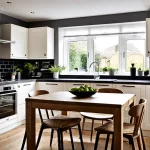Essential Layout Choices for UK Slender Kitchens
When facing the challenge of fitting a kitchen into a narrow space, choosing the right narrow kitchen layout ideas can transform both functionality and style. In the UK, where compact homes are common, the selection between galley and L-shaped kitchens often defines how well the space is utilized.
The galley kitchen is a classic choice for slender areas. It features two parallel work surfaces with a walkway in between, maximizing every inch of wall space for storage and appliances. This layout excels in efficiency by reducing movement between cooking, cleaning, and prep areas. However, it’s vital to ensure the corridor between the surfaces remains wide enough for comfortable navigation, generally no less than 1.2 meters.
Also to read : Transforming a narrow uk kitchen: tips for crafting a practical dining space
Alternatively, the L-shaped kitchen layout suits narrow spaces that open into adjacent rooms or hallways. By aligning cabinets and appliances along two perpendicular walls, it frees additional floor space for movement or a small dining area. This arrangement can create a more open feel while still offering ample countertop and storage options.
To maximize both style and efficiency in these UK kitchen designs, careful attention should be paid to lighting, cabinet height, and integrated appliances. Using vertical storage and reflective surfaces can visually expand the slim space, while strategically placing task lighting ensures safety and convenience during food preparation.
Topic to read : Exploring the benefits of a galley layout for slim uk kitchens: why this design shines
In summary, the choice between galley and L-shaped kitchens hinges on the exact dimensions and the intended use of your slender kitchen. Both layouts offer distinct advantages that, when thoughtfully implemented, optimize narrow UK spaces with functionality and modern design.
Maximizing Storage and Organization
Small kitchens demand space-saving kitchen solutions that are both practical and stylish. One effective approach is incorporating built-in storage such as pull-out units which maximize cabinet interiors by allowing easy access to spices, utensils, and pantry items. Vertical shelving is another clever storage technique. It takes advantage of wall height, freeing up precious counter and floor space. Under-cabinet options like hanging racks or magnetic strips offer additional areas for tools without cluttering work surfaces.
Awkward corners often feel like wasted space, but they can be transformed with carousel or lazy Susan inserts, turning hidden areas into useful storage hubs. Slimline storage ideas, such as narrow rolling carts or slim drawers, fit perfectly into tight gaps between appliances or cabinets, providing extra organization without intruding into your kitchen’s footprint.
When it comes to compact kitchen organization, tailoring solutions to the kitchen’s dimensions is key. Use stackable containers and drawer dividers to keep essentials neatly separated. Keep frequently used items within arm’s reach by organizing them on tiered shelves or in pull-out baskets. These strategies not only enhance functionality but also ensure a clutter-free environment, making the most of every inch in slender kitchens.
Smart Space-Saving Features
Maximizing your kitchen’s functionality without sacrificing style requires space-efficient appliances designed to fit seamlessly into compact areas. These appliances often come in slimmer profiles, enabling you to free up valuable countertop and floor space while maintaining full performance. For example, integrated solutions like built-in ovens and refrigerators blend into cabinetry, creating a clean, uncluttered look.
Fold-away kitchen furniture plays a crucial role in optimizing space, especially for smaller homes. Fold-down tables provide flexible dining or prep areas that tuck away neatly when not in use. Similarly, extendable worktops offer additional surface area only when needed, preventing permanent bulkiness in your kitchen layout.
Beyond furniture and appliances, the strategic use of multi-functional fittings can transform how you experience your kitchen. Think of cleverly designed storage compartments integrated into drawer fronts or under shelves, ensuring every inch is put to practical use. Moreover, combining these features with creative lighting and reflective surfaces significantly enhances the perception of spaciousness. Well-placed lighting highlights corners and work areas, while reflective backsplashes and glossy finishes bounce light around, making the room feel larger and more inviting without adding square footage.
Real-Life UK Kitchen Inspirations
Discovering real UK kitchen makeovers is a great way to envision your own space’s potential. Many UK homeowners face the challenge of working with narrow kitchen examples, where space is limited but functionality must shine. These transformations often involve clever design choices that maximize every inch without costly renovations.
Before and after photos reveal how small changes—like updated cabinetry, lighter colour schemes, and efficient storage solutions—can dramatically improve a kitchen’s usability and ambiance. For example, installing slimline units and integrated appliances helps maintain essential work surfaces while keeping the kitchen open and inviting.
Budget-friendly upgrades are common in these makeovers. Simple swaps such as replacing handles, adding new lighting, or repainting walls can breathe new life into a narrow kitchen. These practical solutions not only enhance appearance but also address layout challenges typical in UK properties, like awkward corners or limited natural light.
In sum, seeing how others have tackled similar kitchen layouts in the UK encourages homeowners to explore flexible, affordable options to transform tight spaces into stylish and efficient cooking areas.
Workflow and Practicality Optimisation
Creating an efficient kitchen workflow starts with understanding how to design spaces that enhance cooking efficiency and support an ergonomic kitchen design. One fundamental principle is the work triangle, which links the sink, stove, and refrigerator. In small kitchens, designing the work triangle requires strategic placement to minimize movement without overcrowding the space. For instance, positioning these elements so the distances between them are short but unobstructed helps save time and energy during meal preparation.
Zoning is another essential strategy. Even in narrow kitchens, clear separation of zones for prep, cooking, and cleaning can be achieved. Allocating specific areas for chopping vegetables, cooking, and washing dishes creates order and supports a smooth progression through tasks. Using vertical storage and compact appliances can further maximize space, making each zone more functional.
To optimise traffic flow and prevent bottlenecks, plan for multiple access points to key areas when possible, and ensure enough clearance between workstations. In busy households, this reduces collisions and frustration, keeping the kitchen safe and productive. Thoughtful layout choices focusing on the work triangle, zoning, and traffic help foster a kitchen environment where cooking efficiency thrives, and daily tasks feel natural and comfortable.

